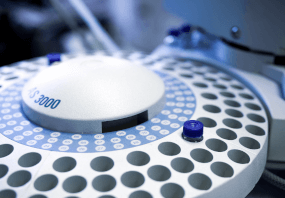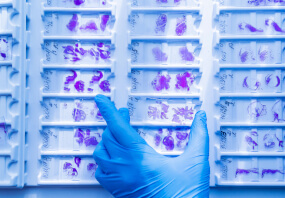Purpose of derivatization Improved volatility, better thermal stability or a lower limit of detection in GC Prerequisite: quantitative, rapid and reproducible formation of only one derivative Halogen atoms introduced by derivatization (e.g., trifluoroacetates) for specific detection (ECD) with the advantage of high sensitivity Influence of elution orders and fragmentation patterns in MS by a specific derivatization Silylation reagent MSHFBA Similar to MSTFA in reactivity and chromatography Recommended application: carboxylic acids, alcohols, phenols, primary and secondary amines and amino acids Used either alone or in combination with a catalyst (TMCS, TSIM) or another silylation reagent with or without solvent The by-product N-methylheptafluorobutyric amide has a lower retention time than the silylating reagent. Especially useful for flame ionisation detection due to the large ratio of fluorine to silicon of 7:1, since degradation of the excess of MSHFBA does not produce SiO2 but volatile, non-corrosive silicon compounds Silylation reagent MSTFA The most volatile trimethylsilyl amide available Very strong TMS donor which does not cause any noticeable FID fouling even after long-time measuring series The already good solution characteristics can be improved by addition of submolar quantities of protic solvents (e.g., TFA for extremely polar compounds such as hydrochlorides) or pyridine (e.g., for carbohydrates). Recommended application: carboxylic acids, hydroxy and ketocarboxylic acids, amino acids, amines, alcohols, polyalcohols, sugars, mercaptans and similar compounds with active hydrogen atoms. Even amine hydrochlorides can be silylated directly. Advantages: complete reaction with high reaction rates, even without a catalyst (1–2 % TMCS or TSIM) The by-product of the reaction (N-methyltrifluoroacetamide) features high volatility and short retention time. Silylation reagent MBDSTFA Silylation reagent which donates a tert-butyldimethylsilyl group (TBDMS) for derivatizing active hydrogen atoms in hydroxyl, carboxyl and thiol groups, primary and secondary amines as well as amino acids Fast reactions (typically 5–20 min) with high yields (> 96%) By-products are neutral and volatile. TBDMS ethers are 104 times more stable than the corresponding TMS ethers; chromatographic retention times are longer due to the large protecting group, which may improve some separations; because of the high molecular ion concentration at M+-57 useful for GC-MS application These products can contain harmful substances which must be specially labeled as hazardous.
Shipping Information:
Hazmat Fee: $65.00 + applicable shipping charges are added after the order is placed.
More Information: https://cenmed.com/shipping-returns
- UPC:
- 51112508
- Condition:
- New
- Availability:
- 3 Days
- Weight:
- 1.00 Ounces
- HazmatClass:
- Yes
- WeightUOM:
- LB
- MPN:
- 701260.11












